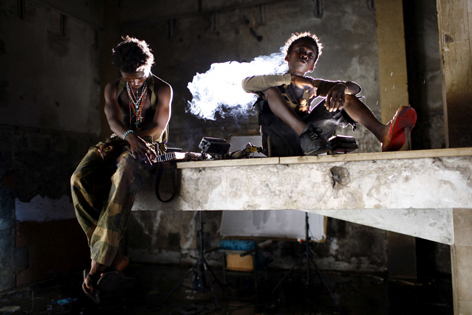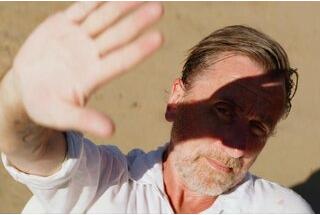Johnny Mad Dog
Paru le La Lettre AFC n°181
In many armed conflicts throughout the world, children were recruited as cheap instruments of war, easily replaceable and easy to condition to kill without apprehension. Forced to take part in terrible actions, sometimes even against their own family, some of them underwent sexual violence. As for those which refused to obey the orders, they were beaten or killed.
In Liberia, where Johnny Mad Dog was produced, there were approximately 100.000 child soldiers during the 14 years of civil war (1989-2003). Under the influence of drugs and alcohol, they were induced to kill. The SBUs were sent on commando missions in the most violent confrontations of the conflict.

Marc, can you tell us more about the film and it’s particular conditions of shooting ?
Jean-Stephane wanted to film young people having taken part in this conflict. A group of youngsters aged 11 to 19 years old was retained, following a casting that he carried out himself in Liberia. These young people were all involved in this war as members of an SBU or as civilian victims.
This was not an ordinary movie : the youngsters were no professional actors, although they had been coached during eight months prior to the shooting. The producers had rented a house where they all could sleep and eat. The beginnings were difficult, because our young "actors", living out on the street since the conflict were not accustomed to any constraint of schedule or discipline. During shooting, they grew quickly impatient when it was necessary to repeat a scene more than two or three times. They were becoming aggressive to each other and came to fight with razor blades or broken bottles. We had to separate them because they really seeamed close to killing each other. Our position was very uncomfortable, it was an enormous responsibility.
Our military adviser, Shevay, plays the part of the SBU commander in the movie. He is immortalised in a photograph by Chris Hondros which was circulated around the world. For most people, Shevay, who survived numerous serious wounds, is an "immortal" , "invisible to bullets". His natural authority was a great help with the young people.1
_1
_

One sees very little blood in the movie, however the perception of violence comes very strongly across…
I saw the children for the first time when I went to Monrovia for location hunting. I was impressed by their glances that get at you, that throw you off balance. One feels like falling into vacuum and wonders : is this vacuum the result of an ultra-violent past or of a hopeless future ?
It was necessary to find a way of filming these glances and this vacuum…
In order to capture this, we needed to be at their eye-level. Jean-Stephane insisted the camera should follow them constantly. We tested Easy Rig and Steadicam. We chose the Steadicam for its flexibility and its possibilities of passing in low mode ; (low camera position).
We filmed all the scenes in mastershots, and changed axes when we were satisfied with the actors’ performance. Thanks to this technique, our young actors "played" the scenes with incredible rhythm from the beginning till the end.
The extreme mobility of the camera enabled me to instantly react and capture the unplanned actions of our actors. In editing, the sequences had to be constructed from these strong moments.
Under these conditions of filming, osmosis between the director and the DOP plays an important role. As soon as the director’s set-up was ready, we started shooting including the rehearsals. This feeling of freedom is brilliant when you operate the camera. Being a very good photographer, Jean-Stephane could quickly analyze an image or what it represents. It was a real pleasure to work together.1
_

The costumes and sets are playing an important role in the movie’s visual universe.
During the civil war, soldiers, be they rebels or of the regular army, paid themselves by plundering civilians’ houses. Many disguised themselves with the clothes they found. The implements which one sees in the film (wigs, wedding gown, butterfly wings…), all these disguises make think of an imaginary world but all that belonged to the reality of that civil war !
The sourrounding beauty of vibrating colors, dimmed by decay, marine breeze and repeated destructions, make Monrovia a unique place. We wanted this very cinematographic texture to disappear behind the seriousness of the film’s subject.
What camera equipment did you use ?
Shooting on 35 mm film would have been too expensive, since we even wanted to shoot the rehearsals.
Between Super 16 and HD, we chose HD. I was a little apprehensive to get started with HD. It was my first experiment and, moreover, under difficult conditions : color palette, dark skins, enormous contrasts, moving between several locations, dust, moisture…
I tested Varicam (Panasonic) and Sony 900R. Luckily, I could rely on the invaluable assistance of Danys Bruyère and Frederique Valay at TSF(equipment rental house).
The director’s obsession was to avoid the "video" look and feel. Following the tests, I thought Panasonic rendered a softer image, closer to film but I was still worried about lack of definition in the wide shots. I finally chose Sony 900R for its greater definition.
We played with the camera’s "details" function, in combination with filters in front of the lens to obtain the definition I liked.
I also noticed that the correction filter 85 in the camera was definitely less good than an 85 filter in front of the lens.
I used Hypergamma 4, which manages the high lights best. As the curve is rather soft, I used a negative "blackgamma" to stick the blacks a little more .
To reduce the great depth of field of the HD, we generally filmed with a wide open stop. The unforeseeable movements of the camera did not simplify the task of my focus puller, Benoît Deleris, and I am impressed with the results he achieved. With the assistance of Yann Tribolle, our impassioned vision engineer, I could make the most out of the Sony 900R camera. I used Fujinon lenses . The camera set up was thus :
- Fujinon lenses
- 2 filters in front of the objective, most of the time a Wratten 85 and a Polarising one
- function details ON, with variable values depending on the width of the shot
- gain - 3dB (less electronic noise)
- Hypergamma 4 and negative blackgamma
- integrated ND filters (camera).

What was your light package and how did you manage night shots ?
I had less problems with contrasts. I find that the HD is tremendous for night sequences because it is very sensitive in low lights. I would have had less details out of film, specially on black skins.
Obviously, all depends on the visual option which one takes and as we know... each film is differen.
I had brought building site projectors for their robustness, 400 and 800W Jokers, Lite Panels, Mizzards and more importantly : reflectors.
For night shots, I mainly used light garlands, Chinese balls as well Lite Panels on batteries. I relied extensively on the existing light, for example a campfire in the night or incoming natural day light. I cut off more light than I added any ! I was influenced by Philippe Rousselot with whom I made some films as a camera operator and whom I admire (Marc was cameraman on Queen Margot and it is Philippe who recommended him to Elisa Larrière, the executive producer of Johnny Mad Dog.)
What about the fears you had concerning the HD-look, now that you saw the shoot on film ?
The Belgian post-production company Hoverlord, based in Liege, was responsible for the digital grading and calibration of the master HD.The French company Buff was responsible for special effects. The digital grading enabled me to harmonize the various skin nuances and reflections. It is a formidable tool. Its only drawback is that one can easily fall for exaggerated effects.For this film, I wanted to remain as natural as possible. I find that in HD, colors become too quickly saturated, especially "red". Already during shooting, I avoided using too many colors in the same shot, I limited myself to no more than two primary colors in each shot. I was very much helped by production designer Alexandre Vivet, whose task was not simple given the visual approach of the film.
I wanted to reduce chromatic chaos to let the viewers’ glance go towards the faces of the actors.
The digital grader, Frank Ravel, understood this sensitivity very well and thus we obtained a master HD corresponding to our high expectations.
We made the "shoot" at GTC with negative grader Christophe Bousquet. I must say that I was astonished by the quality of the transfer. The technical progress is enormous in this field. I am very satisfied with the 35mm film copy.
This film must have been an incredible experience...
It was a very powerful life experience mainly due to the engagement with these youngsters. The necessity of surviving on their own sharpened their personalities. Still children but having taken in charge their own existence : the combination is not obvious to comprehend. Today, their past and the war still seem omnipresent in their spirits and their body expressions. They hold a weapon like we hold a pencil ! The United Nations refused that we use true weapons (the embargo on weapons still holds), but even holding a plastic Kalachnikov, they changed literally. Their muscles inflated, their expressions changed, it was more than playing. I felt ill at ease, as if we were in a situation of danger. It seemed to me that their aggressive attitudes had changed towards the end of the film. Having relived the past had been a kind of therapy for some of them.
On a personal level, this was above all the experience of a meeting and of an exchange with these young people. They had not asked for anything, but they soaked in the attention and the interest brought to them by a group of adults. A feeling of belonging settled in during all these months, reminding everyone of friendship or family references.
To continue this dialogue, two actions exist : the foundation Johnny Mad Dog, created by Jean-Stephane and MNP (production) and the NGO Solidarite Liberia (www.sl-association.org) set up by the film’s technicians and their families and friends.
Technique
Actors : Christopher Minie, Daisy Victoria Vandy, Dagbew TwehProducers : Mathieu Kassovitz and Benoît Jaubert (MNP Entreprise)
Camera assistant : Benoît Deléris
Video engineer : Yann Tribolle
Production designer : Alexandre Vivet
Sound engineer : Yves Comeliau
Gaffer : Eric Waldmann
Camera, light & grip equipment : TSF
Digital intermediate/Digital grader : Hoverlord / Franck Ravel
Special effects : Buff
Scan & shoot : GTC
Negatif grader : Christophe Bousquet
Print : Kodak 5283
Format : Scope 2,35:1
 En
En Fr
Fr




